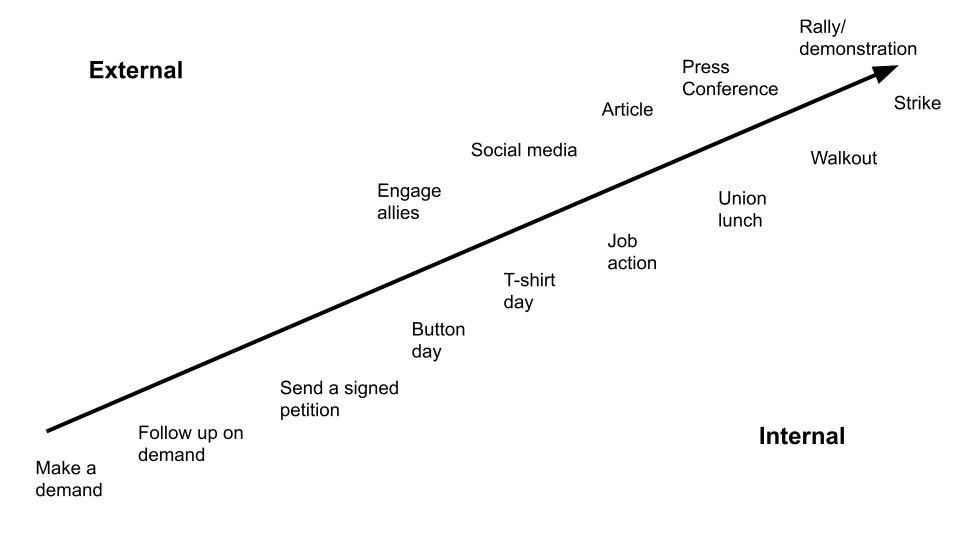Winning is a function of power and leverage. You can have all of the moral and rational arguments, but when your goals come in direct conflict to that of the other side of the negotiating table, trying to reason with management will only get you so far. Sustained pressure shows the bosses that people are serious about their demands and are prepared to continue turning up the heat. You want to make it more annoying to say “no” to your demand than to say “yes”!
Your strategy is your overall goal, like winning a union election or contract. Tactics are the actions you take to move you towards that goal.

Internal actions
Actions should start small and internal and build toward becoming more aggressive and public-facing. Why? Because workers have to act together and that takes practice. Once people have taken small actions they are more likely to be on board with future actions because they’ve had some practice (it can be scary!).
Workplace action examples:
- Button day: Order buttons for union members to wear at work. Try to use a union shop for the buttons like this one!
- Shirt day: Order union shirts with your union logo or a specific message.
- Email a petition to management signed by everyone (or as many as possible!) in the unit.
- Send a delegation of union members to hand-deliver a petition signed by members. Here’s an example.
- Use internal workplace forums and message boards. You can change Slack avatars to a union logo, and change your username (Megan “wants a union” McRobert) or status (“at union lunch”). Here’s a great article on this.
- Enlist non-union colleagues as allies. They may be willing to speak up in support of your effort at meetings or support efforts in a workplace forum.
- Change image backgrounds in virtual meetings (Zoom, Google Meet) to a union logo or hold up signs during staff meetings. Here's how to do it. Here's an example:
Virtual backgrounds have finally come to Google Meet 🙌 pic.twitter.com/55AtwgY8PF
— Sophie Koonin (@type__error) November 2, 2020
- Coordinate asking questions in a town hall or staff meeting. Submit the same or similar questions virtually or electronically (like in a chat box or ahead of the meeting). Even if they don’t answer the question satisfactorily (and they probably won’t if they address it all), you’re showing management that people are taking action and expect accountability.
- Do you have a protected lunchtime or other break? Use it! Order pizza for everyone and gather in the office to talk about next steps to organize. You could also do a union breakfast before work hours officially start. Here are some examples.
- Work to rule is when workers do only what is required of them. This could look like slowing down the workflow, taking breaks, or using the bosses own rules against them (like filing a lot of paperwork). Example here.
- Have a picket sign-making party outside of management’s offices. Bonus points for snacks and music.
Bosses will always try to drive wedges between union members. Internal actions show unity and that your demands are not just coming from a few isolated troublemakers.
Making it public
Sometimes the threat of publicity is enough to move your target. If you threaten to go public, you need to be able to back it up. That’s why internal actions are so important. They give you a clear sense of whether or not your unit is unified and prepared to continue taking action. Internal actions can also be publicized. Already had an internal button day? Have another one, except this time ask everyone to take selfies and post on social media.
Once you’ve exhausted your internal options and know your unit is ready, it’s time to put the bosses on blast. The most commonly known external tool used by unions is going on strike. It may not be necessary and, if it is, taking escalating actions is a way to prepare your unit members and win public support.
External action examples:
- Change twitter avatars to a union logo or coordinated message
- Share issues and updates on social media platforms your members and management use. Share graphics on instagram, livestream a union meeting on Twitch, or co-opt a #hashtag used by the company on Twitter
- Selfies of everyone’s buttons or union shirts (and/or pics of cute pets and babies with union swag!). Like this:
In honor of #NationalPetDay (4/11) and #NationalShelterPetDay (4/30), we're showcasing our union pets, our loving companions as we negotiate an equitable contract.
— Parcast Union (@ParcastUnion) April 9, 2021
Our members will be posting their ParCats, Pups, & other pals in this thread. We'll be RTing them all month! pic.twitter.com/5Y75nsqUIH
- Publicize the petition sent to management and highlight lack of response. Here's a good example:
Yesterday, we sent a petition to management requesting to voluntarily recognize our union. Over 90% of staff signed the petition. pic.twitter.com/i7HSqo26Wg
— FT Specialist Guild (@ftsguild) January 26, 2021
- Publish an op-ed like this.
- Publicize grievances and unfair labor practices:
Solidarity to my former colleagues at @WeArePMWG! 💪 https://t.co/s0iZwEysEK
— David Bradley Isenberg (@davidbradleyeye) April 13, 2021
- Release an open letter to management about unaddressed issues like this one.
- Hold a demonstration during key events, like workers outside of baseball stadium or art workers outside of a museum gala.
- Invite allies and key constituents to a demonstration, with a theme like parents supporting teachers.
- Organize a work stoppage in which you withhold labor for a finite period of time (a few hours, a day). This shows the bosses you can pull off a strike and can also inflict damage if done during key business times.
Tools for brainstorming actions
One of the ways that people overcome fear is by seeing that they’re not alone and that there is power in numbers. Actions can also be empowering and even fun! You can refer to some of the ideas above and hear are some prompts to help brainstorm creative actions:
- When are the bosses all in the office?
- Are there any big holidays coming up? (send valentines day cards to the union bargaining committee, send postcards to HR about the vacations you couldn’t take, send holiday cards to CEO “all i want for christmas is a fair contract”)
- Are there big events coming up (like an important meeting or a donor visit)?
- Are there places where management really needs workers? A busy time or important project? Is there an expectation that everyone will attend an upcoming event?
Actions are also an opportunity to bring in new people and develop new union leaders. Is someone very vocal about wanting to take a next step? Ask them to take the lead on drafting the next petition. Show people this chart to introduce the concept of escalating actions and generate new ideas.
Organizing is a marathon, not a sprint
By organizing escalating collective actions, you’re essentially training a whole bunch of people to run at the same pace and toward the same destination. Stay hydrated, start small, and know where you are trying to go.



